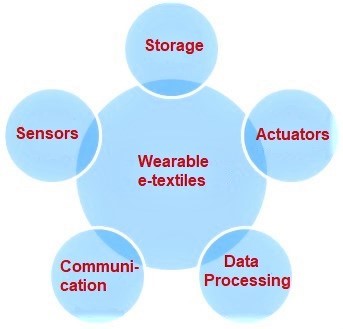Recent Trends in Wearable Electronic Textiles (e-Textiles): A Mini Review
Abstract
 Abstract Views: 0
Abstract Views: 0
Wearable electronic textiles (e-textiles) have the ability to sense, respond, and adjust in multiple environmental stimuli, which can interact with the human brain's capability for cognition, reasoning, and activation. Moreover, they have the ability to generate and store energy, keep track of the wearer's health, and react to varying situations. Conductive polymers, metal-wrapped yarns, as well as, carbon nanotubes with silver, copper, and gold nanoparticles are used in a variety of yarn structures to design circuits, switches, and fabrics directly. Knitting, stitching, embroidery, and other integration techniques are used to combine electronic components and electrical interconnects to develop flexible electronic clothing and smart wearables. For this purpose, controlled sensors, actuators, conductive embroidered or printed fabric, planer yarn, data transfer devices, conductive inks, electromagnetic shielding, power supply, and other components are incorporated in e-textiles design. Despite the progress made so far, wearable e-textiles still, lack the required performance and device features along with the issues related to complex fabrication techniques, end-of-life processing and sustainability. Hence, this review aims to discuss the recent developments, which address the future challenges concerning electronic (e-textiles).
Downloads
References
A. Ferri, M.R. Plutino, and G. Rosace, “Recent trends in smart textiles: Wearable sensors and drug release systems,” AIP. Conf. Proc., vol. 2145, no. 1, Aug. 2019, doi: https://doi.org/10.1063/1.5123575
W. Weng, P. Chen, S. He, X. Sun, and H. Peng, “Smart electronic textiles,” vol. 55, no. 21, pp. 6140–6169, Mar. 2016, doi: https://doi.org/10.1002/anie.201507333
T. Hughes-Riley, T. Dias, and C. Cork, “A historical review of the development of electronic textiles,” vol. 6, no. 2, Art. no. 34, May 2018, doi: https://doi.org/10.3390/fib6020034
L. Wang and K. J. Loh, “Wearable carbon nanotube-based fabric sensors for monitoring human physiological performance,” Smart Mater. Struct., vol. 26, no. 5, Art. no. 055018, 2017, doi: https://doi.org/10.1088/1361-665X/aa6849
Y.-Q. Li, P. Huang, W.-B. Zhu, S.-Y. Fu, N. Hu, and K. Liao, “Flexible wire-shaped strain sensor from cotton thread for human health and motion detection,” Sci. Rep., vol. 7, Art. no. 45013, 2017, doi: https://doi.org/10.1038/srep45013
R. Fernández-Garcia, and I. Gil, “An alternative wearable tracking system based on a low-power wide-area network,” Sensors, vol. 17, no. 3, Art. no. 592, Mar. 2017, doi: https://doi.org/10.3390/s17030592
Y. Gao, C. Xie, Z. Zheng, “Textile composite electrodes for flexible batteries and supercapacitors: opportunities and challenges,” Adv. Energy Mater., vol. 11, no. 3, Art. no. 2002838, Nov. 2021, doi: https://doi.org/10.1002/aenm.202002838
K. Meng, et al., “A wireless textile-based sensor system for self-powered personalized health care,” Matter., vol. 2, no. 4, pp. 896–907, Apr. 2020, doi: https://doi.org/10.1016/j.matt.2019.12.025
W. Fan, et al., “Machine-knitted washable sensor array textile for precise epidermal physiological signal monitoring,” Sci. Adv. vol. 6, no. 11, Mar. 2020, doi: https://doi.org/10.1126/sciadv.aay2840
X. Tian, et al., “Wireless body sensor networks based on metamaterial textiles,” Nat. Electron., vol. 2, pp. 243–251, 2019, doi: https://doi.org/10.1038/s41928-019-0257-7
J. Xiong, J. Chen, and P.S. Lee, “Functional fibers and fabrics for soft robotics, wearables, and human–robot interface,” Adv. Mater., vol. 33, no. 19, Mar. 2021, doi: https://doi.org/10.1002/adma.202002640
X. Shi, et al., “Large-area display textiles integrated with functional systems,” Nature, vol. 591, pp. 240–245, Mar. 2021, doi: https://doi.org/10.1038/s41586-021-03295-8
N. Karim, et al., “Scalable production of graphene-based wearable e-textiles”, ACS Nano., vol. 11, no. 12, pp. 12266–12275, Nov. 2017, doi: https://doi.org/10.1021/acsnano.7b05921
S. Zaman, X. Tao, C. Cochrane, V. Koncar, “Smart e-textile systems: A review for healthcare applications,” vol. 11, no. 1, Art. no. 99, Dec. 2022, doi: https://doi.org/10.3390/electronics11010099
H. L. O. Júnior, R. M. Neves, F. M. Monticeli, and L. D. Agnol, “Smart fabric textiles: Recent advances and challenges,” Textiles, vol. 2, no. 4, pp. 582–605, Nov. 2022, doi: https://doi.org/10.3390/textiles2040034
K. Mondal, “Recent advances in soft e-textiles,” Inventions, vol. 3, no. 2, Art. no. 23, Apr. 2018, doi: https://doi.org/10.3390/inventions3020023
J. S. Meena, S. B. Choi, S.-B. Jung, and J. W. Kim, “Electronic textiles: New age of wearable technology for healthcare and fitness solutions,” Mater. Today Bio., vol. 19, Art. no. 100565, Apr. 2023, doi: https://doi.org/10.1016/j.mtbio.2023.100565
A. Libanori, G. Chen, X. Zhao, Y. Zhou, and Jun. C, “Smart textiles for personalized healthcare,” Nat. Electron., vol. 5, no. 3, pp. 142–156, Mar. 2022, doi: https://doi.org/10.1038/s41928-022-00723-z
M. Rizwan, M. W. A. Khan, L. Sydänheimo, J. Virkki, and L. Ukkonen, “Flexible and stretchable brush-painted wearable antenna on a three-dimensional (3-D) printed substrate,” IEEE Antennas Wirel. Propag. Lett., vol. 16, pp. 3108–3112, Oct. 2017, doi: https://doi.org/10.1109/LAWP.2017.2763743
Z. Wen, et al., “Self-powered textile for wearable electronics by hybridizing fiber-shaped nanogenerators, solar cells, and supercapacitors,” Sci. Adv., vol. 10, no. 2, Oct. 2016, doi: https://doi.org/10.1126/sciadv.1600097

Copyright (c) 2023 Muhammad Awais Naeem, Kashif Javed, Ahmad Fraz, Faiza Anwar

This work is licensed under a Creative Commons Attribution 4.0 International License.

This work is licensed under a Creative Commons Attribution 4.0 International License. Authors retain copyright and grant the journal right of first publication with the work simultaneously licensed under a Creative Commons Attribution (CC-BY) 4.0 License that allows others to share the work with an acknowledgement of the work’s authorship and initial publication in this journal.





